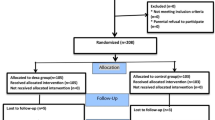Abstract
Purpose
Unilateral spinal anesthesia is performed to provide restriction of sympathetic and motor block. The purpose of this study is to compare the effect of different speeds of intrathecal injection on unilateral spinal anesthesia.
Methods
The patient cohort comprised 66 patients who were placed in the lateral position with the side to be operated on dependent. After dural puncture, the needle aperture was turned towards the dependent side, and hyperbaric 0.5% bupivacaine was injected at a rate of 1 ml/min in Group Slow patients (Group S, n = 33) or 0.5 ml/min in Group Extra Slow patients (Group ES, n = 33). The lateral position was maintained for 15 min. Skin temperature, loss of pinprick sensation, and degree of motor block were recorded.
Results
There were significant differences in the characteristics of the non-operative side between the groups when on the block. Sensorial block was unilateral in 25 (75.8%) patients in Group S and in 29 patients in Group ES (87.9%) 15 min post-injection. At the end of the operation (approximately 50 min after spinal anesthesia), strictly unilateral anesthesia was present in 31 patients in Group ES (93.9%) and in 22 patients in Group S (66.6%) (p < 0.05). Unilateral sensory and motor block were observed in both groups, and the incidence of strict unilateral block was significantly higher in group ES patients.
Conclusions
The result of the study show that the extra-slow injection of hyperbaric bupivacaine provided strictly unilateral sensorial and sympathetic block in 93.9 and 87.9% of the patients, respectively, and that a slow injection of low doses of hyperbaric 0.5% bupivacaine 1 ml was sufficient to provide unilateral spinal anesthesia.


Similar content being viewed by others
References
Hocking G, Wildsmith JAW. Intrathecal drug spread. Br J Anaesth. 2004;93:568–78.
Janik R, Dick W, Stanton-Hicks M. The effect of the injection speed on the blockade characteristics of hyperbaric bupivacaine and tetracaine in spinal anesthesia. Reg Anaesth. 1989;12:63–8.
Stienstra R, Gielen M, kroon JW, Van Poorten F. The influence of temperature and speed of injection on the distribution of a solution containing bupivacaine and methylene blue in spinal canal model. Reg Anesth. 1990;15:6–11.
Casati A, Fanelli G, Cappelleri G, Aldegheri G, Berti M, Senatore R, Torri G. Effects of speed of intrathecal injection on unilateral spinal block by 1% hyperbaric bupivacaine. A randomized, double-blind study. Minerva Anesthesiol. 1999;65:5–10.
Casati A, Fanelli G, Cappelleri G, Leoni A, Berti M, Aldegheri G, Torri G. Does speed of intrathecal injection affect the distribution of 0.5% hyperbaric bupivacaine? Br J Anaesth. 1998;81:355–7.
Greene NM. Distribution of local anesthetic solutions within the subarachnoid space. Anesth Analg. 1985;64:715–30.
Horlocker TT, Hebl JR. Anesthesia for outpatient knee arthroscopy: is there an optimal technique? Reg Anesth Pain Med. 2003;28:58–63.
Nair GS, Abrishami A, Lermitte J, Chung F. Systematic review of spinal anaesthesia using bupivacaine for ambulatory knee arthroscopy. Br J Anaesth. 2009;102:307–15.
Enk D. Unilateral spinal anaesthesia: gadget or tool? Curr Opin Anaesthesiol. 1998;11:511–5.
Korhonen AM. Use of spinal anaesthesia in day surgery. Curr Opin Anaesthesiol. 2006;19:612–6.
Casati A, Fanelli G, Cappelleri G, Aldegheri G, Leoni A, Casaletti E, Torri G. Effects of spinal needle type on lateral distribution of 0.5% hyperbaric bupivacaine. Anesth Analg. 1998;87:355–9.
Liu SS, McDonald SB. Current issues in spinal anesthesia. Anesthesiology. 2001;94:888–906.
Fanelli G, Borghi B, Casati A, Bertini L, Montebugnoli M, Torri G. Unilateral bupivacaine spinal anesthesia for outpatient knee arthroscopy. Can J Anesth. 2000;47:746–51.
Kaya M, Oğuz S, Aslan K, Kadıoğulları N. A low dose bupivacaine: a comparison of hyperbaric and hypobaric solutions for unilateral spinal anesthesia. Reg Anesth Pain Med. 2004;29:17–22.
Casati A, Fanelli G, Aldegheri G, Colnaghi E, Casaletti E, Cedrati V, Torri G. Frequency of hypotension during conventional or asymmetric hyperbaric spinal block. Reg Anesth Pain Med. 1999;24:214–9.
Casati A, Fanelli G. Unilateral spinal anesthesia. State of the art. Minerva Anesthesiol. 2001;67:855–62.
Chamberlain PD, Chamberlain BD. Changes in the skin temperature of the trunk and their relationship to sympathetic blockade during spinal anesthesia. Anesthesiology. 1986;65:139–43.
Perhoniemi V, Linko K. Effect of spinal versus epidural anesthesia with 0.5% bupivacaine on lower limb blood flow. Acta Anesthesiol Scand. 1987;31:117–21.
Meyer J, Enk D, Penner M. Unilateral spinal anesthesia using low-flow injection through a 29-gauge quincke needle. Anesth Analg. 1996;82:1188–91.
Bridenbaugh BO, Greene NM, Brull SJ. Spinal (subarachnoid) neural blockade. In: Cousins MJ, Bridenbaugh BO, editors. Neural blockade in clinical anesthesia and management of pain, Chap 7. 3rd edn. Philadelphia: Lippincott-Raven; 1998. pp. 203–41.
Holman SJ, Robinson RA, Beardsley D, Stewart SF, Klein L, Stevens RA. Hyperbaric dye solution distribution characteristics after pencil-point needle injection in a spinal cord model. Anesthesiology. 1997;86:966–73.
Author information
Authors and Affiliations
Corresponding author
About this article
Cite this article
Apaydın, Y., Erk, G., Sacan, O. et al. Characteristics of unilateral spinal anesthesia at different speeds of intrathecal injection. J Anesth 25, 380–385 (2011). https://doi.org/10.1007/s00540-011-1111-x
Received:
Accepted:
Published:
Issue Date:
DOI: https://doi.org/10.1007/s00540-011-1111-x




